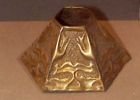 | Find Louisiana State Museum on Facebook |
 | Find Louisiana State Museum on Twitter |
| 2016 Sunset Report |
| OLG & DCRT Strategic Plan 2020-21 through 2024-25 |

- Quality - Louisiana State Library
85% of the users of the State Library indicated that the State Library's services and resources was a good value for the State.Source: The Impact of the Louisiana Department of Culture, Recreation and Tourism on Louisiana's Economy and Quality of Life for Louisiana's Citizens - June 2006
- Louisiana's deep water ports
Did you know that Louisiana's five deep water ports handle more than 457 million tons of U.S. waterborne commerce a year? - Quality - Louisiana State Library
85% of the users of the State Library indicated that the State Library's services and resources was a good value for the State.Source: The Impact of the Louisiana Department of Culture, Recreation and Tourism on Louisiana's Economy and Quality of Life for Louisiana's Citizens - June 2006
- Atchafalaya Heritage Area
The Atchafalaya Heritage Area has been designated by Congress as a National Heritage Area.
- Impact - DCRT Returns Investment Dollars to Louisiana
For every state tax dollar spent by the Department of Culture, Recreation and Tourism, $5.86 is returned to the State Treasury and citizens of Louisiana.Source: The Impact of the Louisiana Department of Culture, Recreation and Tourism on Louisiana's Economy and Quality of Life for Louisiana's Citizens - June 2006
- Impact - Louisiana Office of Tourism Tops Returns on Investment
$13.90 is the return on investment for every dollar spent by the Office of Tourism. Over 175,000 people were directly employed by the Louisiana travel and tourism industry in 2004. In terms of production, $5.9 billion (3.8%) of Louisiana's Gross State Product was directly attributable to expenditures by visitors to LouisianaSource: The Impact of the Louisiana Department of Culture, Recreation and Tourism on Louisiana's Economy and Quality of Life for Louisiana's Citizens - June 2006
- Impact - Supporting the Louisiana Arts
Every dollar in state support for the Arts leverages $7 in earned and contributed revenue. Louisiana's cultural enterprises provide nearly 144,000 jobs for Louisiana citizens, accounting for 7.6% of total employment. Arts has a total economic impact of $934 million in Louisiana.Source: The Impact of the Louisiana Department of Culture, Recreation and Tourism on Louisiana's Economy and Quality of Life for Louisiana's Citizens - June 2006
- Impact - Visitors Generate State Revenue
In terms of tax revenues, visitor spending accounted for $677 million of 2004 Louisiana revenues, or 8.3% of the total 2004 State Budget.Source: The Impact of the Louisiana Department of Culture, Recreation and Tourism on Louisiana's Economy and Quality of Life for Louisiana's Citizens - June 2006
- Quality - Louisiana State Museums
95% of State Museum's visitors strongly agreed or agreed that the State Museum was an educational experience and has expanded their awareness of Louisiana's cultural history.Source: The Impact of the Louisiana Department of Culture, Recreation and Tourism on Louisiana's Economy and Quality of Life for Louisiana's Citizens - June 2006
- Quality - Historic Preservation and the Arts
78-80% of Louisiana residents believe that historic preservation and arts are important and should be high priorities.Source: The Impact of the Louisiana Department of Culture, Recreation and Tourism on Louisiana's Economy and Quality of Life for Louisiana's Citizens - June 2006
- Impact - Louisiana Serve Program
The Louisiana Serve Program in the Office of Lieutenant Governor returns 2.8 million in non-state revenue to Louisiana. - Impact - Louisiana State Museum
The Office of State Museum returns $6.99 for every tax dollar spent.Source: The Impact of the Louisiana Department of Culture, Recreation and Tourism on Louisiana's Economy and Quality of Life for Louisiana's Citizens - June 2006
- Impact - Louisiana State Parks
Visitor spending at Louisiana State Parks returns $3.23 in state taxes for every dollar spend on operating and maintaining all our beautiful parks. Out-of-state visitors to Louisiana State Parks spent almost $12 million in Louisiana and produced an economic impact of over $24 million. Louisiana residents spent another $29.2 million while visiting the parks.Source: The Impact of the Louisiana Department of Culture, Recreation and Tourism on Louisiana's Economy and Quality of Life for Louisiana's Citizens - June 2006
- Impact - Scenic Byways Program
The Scenic Byways program leverages $1.56 for every dollar spent by the program.Source: The Impact of the Louisiana Department of Culture, Recreation and Tourism on Louisiana's Economy and Quality of Life for Louisiana's Citizens - June 2006
- Louisiana State Parks and the National Register
Thirteen Louisiana State Parks sites are on the National Register of Historic Places. They include:
• Audubon State Historic Site
• Centenary State Historic Site
• Fort Pike State Historic Site
• Fort Jesup State Historic Site
• Longfellow-Evangeline State Historic Site
• Mansfield State Historic Site
• Marksville State Historic Site
• Plaquemine Lock State Historic Site
• Port Hudson State Historic Site
• Poverty Point State Historic Site
• Otis House at Fairview-Riverside State Park
• Rosedown Plantation State Historic Site
• Winter Quarters State Historic Site - Louisiana State Parks Visitation
Nearly two million people visited a Louisiana State Park last year. - Louisiana State Parks Grow and Renew
The Louisiana Office of State Parks has spent nearly $80 million in major construction projects since 2004, providing two brand-new parks and a new historic site, adding cabins and campsites to existing parks and building visitor center at one park, the preservation area and three historic sites. - Louisiana State Parks Wireless Internet
The Louisiana Office of State Parks provides free wireless internet access at all 20 recreational parks. Extensive coverage areas include most cabins, RV slips and campsites. - Louisiana State Parks Online Reservations
You can now make online reservations for cabins, campsites, lodges and group camps – at www.ReserveLaStateParks.com - Louisiana State Parks Honors National Parks Service Senior Pass Program
Visitors who hold an America the Beautiful Senior or Access Pass, and whose home State Park system honor the America the Beautiful passes for camping discounts, are entitled to a 50% reduction on camping fees at Louisiana State Parks. Certain restrictions apply, see State Parks' fees & facilities page for more information. - Louisiana State Parks Draw Media Attention
Louisiana State Parks sites have been featured in movie and television releases including "True Detective," CBS’ "Zoo," and "NCIS: New Orleans," "G.I. Joe: Retaliation," "Selfless," "Devil’s Due," and commercials for Popeyes and Toyota. - Capitol Park Welcome Center
The main meeting room in the Capitol Park Welcome Center is named after Margaret Taylor, wife of U.S. President Zachary Taylor. The couple resided in a small house near the present day location of Capitol Park until Taylor was elected to the Presidency.
| Table of Contents | Section 1 | Section 2 | Section 3 | Section 4 | Selected Bibliography |
Metalworking
Mary Given Sheerer initiated a new craft program at the College when she was unable to find acceptable commercial lampshades for the ceramic bases produced at the Pottery. Recalling the 1861 actions of William Morris, Sheerer found no alternative but to fabricate the shades herself. The first pierced brass lampshade was made by Sheerer in the early 1900's, the jewelry program initiated in 1909. (Sheerer also conducted courses in beading and leaded glass for the fabrication of lampshades, although little of this fragile work was done or survived.) The instant success of the jewelry program, accompanied by numerous orders, prompted Ellsworth Woodward to lament that "... it should have been introduced long ago."
Metal wares were made simply at the College, fashioned by cutting and polishing sheet brass or silver. According to a 1910 Ellsworth Woodward Womans Era article, "Girls become excellent silversmiths in the interests of personal adornment." It is entirely possible, however, that the more dangerous or technically demanding tasks, soldering for instance, were performed by local professional smiths. The theory makes sense since art school administrators were inclined to hire men to perform tasks deemed too risky or dirty for the female students. Equipment required for more sophisticated fabrication might also have been prohibitably expensive for the College.
 |
There is also evidence to support that students manipulated ready-made items in the metal shop. It is unlikely that pieces requiring special equipment and techniques to fabricate, such as flatware and hollowware, were made at the College. Commercially-made spoons exist, however, that indicate the coeds hand-hammered them in the art school metal shop.
Embroidery
Although the needlework process had remained pre-industrial, needle arts were exceedingly popular during the Arts and Crafts revival. Traditionally a female skill, the work required little equipment and could be done anywhere. William Morris incorporated many textile arts into his home furnishings company including embroidery, fabric dyeing, and tapestry and rug-knotting. Morris taught his wife, Jane, medieval embroidery techniques. At the turn of the century, Morris’ daughter, May, herself an accomplished needlewoman, toured the United States to lecture on Arts and Crafts ideals, and in particular, embroidery.
The needleart program was begun at Newcomb in 1902 by the art department’s first instructor, Gertrude Roberts Smith. Like the pottery, both the materials and the underlying principles of fabrication remained well within the Arts and Crafts realm. Designs were inspired by natural, local motifs such as camellias, poinsettias and roses. And, as Gustav Stickley recommended in his Arts and Crafts publications, Newcomb used woven unbleached flax or linen to support silk floss worked in darning, satin and buttonhole stitches. Emphasizing simplicity and restraint, Stickley remarked that the embroidery of scarfs, table squares, luncheon and dinner sets, "is the kind of needlework that any woman can do."
The Newcomb embroideries were exquisitely and expertly executed. In 1910, Ellsworth Woodward boasted of their success, stating that "...the Art of Embroidery... is rapidly gaining in volume and popularity upon the pottery. Newcomb Embroidery has made for itself a leading position among the needle crafts of the land." Embroidered pieces were displayed with Newcomb pottery as early as the 1903 St. Louis World’s Fair.
Newcomb needlework was judged by jury, as the other crafts, before being sold in the art department sales room, or exhibited or retailed through arts and crafts societies and stores. Sadly, few of the surviving examples bear the embroidered signatures of the needleworker.
 Drawstring Bag Unidentified embroiderer |
Bookbinding
As literacy increased in the 19th century, the demand for more and cheaper books was met by mass-production, industrial printing techniques.
The art of making fine hand-crafted books was revived during the Arts and Crafts movement. William Morris founded his Kelmscott Press in 1890 and the following year in London published his first book, The Story of the Glittering Plain. Published the same year in Boston, Morris’ book inspired a new generation of private American printing houses, primarily in the Northeast and Midwest. The revival of fine printing came to be known as the "Kelmscott revival." The Roycroft Press in East Aurora, New York, brought more Arts and Crafts books to American households than any other press.
Although bookbinding was an early and successful Arts and Crafts industry, it was not added to the Newcomb crafts program until the fall of 1913. The bindery was under the direction of Lota Lee Troy, who studied at Columbia University not only with Arthur Wesley Dow, but also two well-known English book makers, Walter Roach and William Mason.
Like other revival art printers, Newcomb emulated the Gothic book style by using thick laid paper with deckle edges, heavily inked in medieval typeset and with woodcuts or engravings for illustrations. Students made their own decorative end papers, meticulously sewed the spines and hand-tooled the leather book covers.
 Book Leather bound and tooled by Eunice Bassich c. 1935 |
 |  |  |  |
| Books Leather bound and tooled by Lilian Rogers c. 1935 | |||

